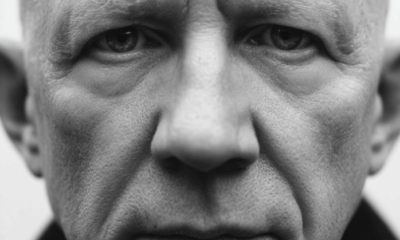Motivation
50 Cent Scored Half a Billion Dollars – How 50 Made a Killing Off Water
In “The Big Payback: The History of the Business of Hip-Hop,” author Dan Charnas traces how rap grew from its obscure roots in the ghettos of 1970s New York to its culmination as the world’s predominant youth pop culture and a multibillion-dollar industry.
The event that epitomized just how far hip-hop had come was the headline-grabbing partnership between the rapper 50 Cent and the upstart beverage company Glaceau, the maker of VitaminWater. It may well have been the biggest deal in hip-hop history, propelling 50 Cent’s personal net worth toward a half-billion dollars.
In this excerpt, Charnas outlines how it happened.
By the summer of 2003, 50 Cent’s debut album, “Get Rich or Die Tryin’,” had sold more than 5 million copies, and he was easily on his way to becoming a multimillionaire on these sales alone.
Nonetheless, the rapper from Queens, who was born Curtis Jackson and had begun his career on the reputation of being shot nine times (a bullet was still lodged in his tongue), wasn’t content to remain a recording artist.
His young manager, Chris Lighty, himself a Bronx street kid turned businessman, was well-positioned to exploit 50’s stardom by creating multiple income streams. Lighty had come out of the Def Jam fold and managed such stars as Missy Elliott and LL Cool J.
With Lighty, 50 Cent created the “G-Unit” brand, including a record company, a clothing company, and a sneaker deal with Reebok’s RBK line. The G-Unit Clothing Company was a joint-venture deal, with hip-hop-influenced designer Marc Ecko fronting the money, handling the manufacturing and distribution, and splitting the profits fifty-fifty with 50.
At his Violator management company (named after a rough crew that Lighty ran with as a kid), Lighty helped pioneer the use of 900 numbers for his artists.
Over a decade later, he negotiated a different kind of phone deal: 50 Cent cellular ringtones to be sold for up to $2.99 per download. Lighty inked other agreements, too: a video game and a biopic with MTV Films and Paramount Pictures. When the agency that represented Lighty, CAA, balked at representing a rapper so closely associated with violence, Lighty secured a deal with an eager William Morris.
One of Lighty’s business acquaintances was Rohan Oza, a marketing executive who has just moved from Coca-Cola to a small Queens, N.Y., beverage company called Glaceau. Oza considered himself not a brand manager, but a brand messiah. He believed that passionate proselytizing of his products could transcend costly corporate ad campaigns.
Oza’s Vitamin Water brand was doing well at more than $100 million in sales, second only to Pepsi’s Propel brand in the $245 million “enhanced-water” market. He knew how to take them out.
Stealing a page from the hip-hop street-team and word-of-mouth ethos, Oza created a fleet of 10 “Glaceau Vitamin Water Tasting Vehicles,” staffed by 200 “hydrologists,” to cross the country and spread the gospel of Vitamin Water’s growing line. But hydrologists working one-on-one with consumers wouldn’t break Vitamin Water out of the gourmet-deli and new-age-health-food market.
Oza needed more than brand messiahs to convert individuals. He needed brand ambassadors to influence millions. That’s when Oza saw a commercial for RBK sneakers in which Lighty, rather sneakily, had his artist, 50 Cent, chug a bottle of Vitamin Water.
In a phone call soon thereafter, Lighty told Oza that he wanted to find a way to work together to make Vitamin Water huge. It turned out that 50 Cent had a true love of the product. He had grown up around alcoholics, so he didn’t drink. Instead, he spent hours a day working out and ate healthy. Like Oza who got bored with imbibing the recommended eight glasses of plain water a day, 50 had found Vitamin Water a more pleasurable way to hydrate.
On Oza’s desk in his New York office, at that very moment, was a test bottle of a new Vitamin Water flavor, recently formulated by Glaceau’s head of product development, Carol Dollard, who had worked hard to get more vitamins and nutrients into their drinks – much more than the 2 to 3 percent of the recommended daily allowance in other “enhanced” waters.
Recently, Oza had asked Dollard for a product that would make it easy to highlight this difference. She had returned with a flavor that contained 50 percent of the RDA of seven different vitamins and minerals. Oza’s marketing team responded with a great name for the new variety: Formula 50.
What better way to collaborate, Oza suggested, than to have 50 Cent endorse this new product? But Lighty didn’t want an endorsement deal. He didn’t want cash. “We want to invest,” Lighty said.
By 2004, 50 Cent was undoubtedly one of the world’s biggest pop stars. But it took some amount of convincing on Oza’s part to overcome the trepidation of Glaceau CEO Darius Bikoff and president Mike Repole. 50 Cent’s association with gunplay presented a problem: What if their chief spokesperson ended up dead in a rap beef?
But the 50 Cent who showed up for his first meeting with Bikoff was surprisingly different from the rapper’s public image: calm, respectful and deliberate, without too many flamboyant flourishes. Lighty was the rapper’s perfect business complement.
In the weeks and months thereafter, Lighty and Oza hammered out the terms of a deal. 50 Cent would take a stake in the privately owned company, one that would graduate over time and escalate if the company hit certain numbers.
The two entities – 50 Cent on one hand and Glaceau on the other – signed an agreement of mutual confidentiality. Still, word got around that Lighty had negotiated something close to, but not more than, 10 percent of the value of the company. During these discussions, Lighty and 50 deliberated the attributes of their new product. Oza presented the pair with several flavor options for Formula 50. For Chris Lighty, the choice was simple.
Despite the high-minded science of Glaceau, their product was basically a smarter, more upscale, more aspirational version of the ultimate ghetto beverage on which Lighty and 50 had grown up: the “quarter-waters” sold in every bodega, deli and convenience store from Queens to Compton.
The quarter-waters (so named because they once cost 25 cents) were just like the Kool-Aid everybody drank at home. However, nobody drank wild flavors like strawberry and kiwi in the ‘hood, because they drank grape. Formula 50 had to be grape. Oza hated the comparison to such base beverages, but he had to admire the thought process of his new partners.
 The 50 Cent-Vitamin Water deal was announced in October 2004. Behind the scenes, the relationship between the two parties wasn’t always smooth. When Lighty, in one of his first interviews about the deal, spoke of building the brand with the ultimate goal of selling it, Darius Bikoff phoned Lighty, screaming at him for disclosing the strategy. Within a few hours, Bikoff looked up to find a livid Lighty in his office, glowering at him. Lighty had driven from Manhattan to Queens to tell Bikoff one thing. “Don’t curse at me,” Lighty said, a heartbeat away from becoming a Violator once more.
The 50 Cent-Vitamin Water deal was announced in October 2004. Behind the scenes, the relationship between the two parties wasn’t always smooth. When Lighty, in one of his first interviews about the deal, spoke of building the brand with the ultimate goal of selling it, Darius Bikoff phoned Lighty, screaming at him for disclosing the strategy. Within a few hours, Bikoff looked up to find a livid Lighty in his office, glowering at him. Lighty had driven from Manhattan to Queens to tell Bikoff one thing. “Don’t curse at me,” Lighty said, a heartbeat away from becoming a Violator once more.
Once they understood each other, Bikoff and Lighty, Vitamin Water and 50 Cent built a strong alliance. Soon billboards and bus stops across the country linked the images and joined the fates of two upstarts from Queens – one a scrappy, new-age beverage company; the other a pugnacious, provocative rapper with an eye for opportunity and a history of hitching himself to winners.
In March 2007, Chris Lighty and his friend Sean Combs were riding together from Heathrow airport to a London hotel in the back of a Maybach when Combs got some news over the phone. Fellow rap superstar Jay-Z and his two fashion-entrepreneur partners, Alex Bize and Norton Cher, had just sold the rights to their Rocawear trademark to a public company, the Iconix Brand Group.
Lighty could not stop repeating the number he heard, as he stared at Combs in disbelief. “Two hundred million? Two hundred million?” Actually, at $219 million, the sale of the Rocawear brand name was, at the time, the biggest deal in hip-hop history. Combs responded in the only way he knew how. “I need a billion for mine,” he huffed. But of those two men, it would be Lighty who reached that symbolic mark first.
Just two month later, in May 2007, the Coca-Cola Company purchased Glaceau for $4.1 billion. In the media, initial reports put 50 Cent’s cashout at $400 million, calculated by dividing the purchase amount by 50 Cent’s reputed 10 percent share. But in reality, 50 Cent’s take was much less. Another stakeholder needed to be paid off first – the diversified Indian conglomerate Tata had invested $677 million for 30 percent of Glaceau in 2006, and got $1.2 billion when Coca-Cola bought them out.
When all the other costs had been deducted, 50 Cent was thought to have walked away with a figure somewhere between $60 million and $100 million, putting his net worth at nearly a half billion dollars.
On his next album, 50 Cent could barely contain his own incredulity at the power of the dollar. “I took quarter-water, sold it in bottles for two bucks,” he rapped. “Coca-Cola came and bought it for billions. What the [f#!k]?” But Lighty silently pocketed his 15 percent and kept it moving.
Life
10 Research-Backed Steps to Create Real Change This New Year
This New Year could finally be the one where you break old patterns and create real, lasting change.

Every New Year, we make plans and set goals, but often repeat old patterns. (more…)
Life
How Sports Quietly Build Kids’ Emotional Intelligence And Why It Matters for Life
Sports create a natural loop of awareness and action that kids carry into real life

A missed shot in basketball. A tumble during a gymnastics routine. A tough loss in karate sparring. These moments can feel huge to a child, sparking frustration, embarrassment, or even tears. (more…)
Did You Know
7 Surprising Life Lessons Video Games Taught Me That School Never Did
Want to get better at something? Study the pros. That applies to both life and video games

If you play video games, you’ll quickly discover you’re not alone. You’ll meet people who share your interests, challenge your skills, and even teach you something new about yourself. I started gaming when I was 10. A classmate invited me to play after school, and I was hooked. (more…)
Featured
The Psychology of Motivation: How to Keep Moving Forward Every Day
Discover how daily habits, self-discipline, and a few clever strategies can spark your drive and focus.

You wake up on a typical Monday morning, glance at your clock, and realize it’s time to get moving. How do you summon that inner drive to deal with your responsibilities with a genuine smile on your face? (more…)
-

 Business4 weeks ago
Business4 weeks agoWhy Your E-Commerce Fulfilment Is Probably Broken (And How to Fix It)
-

 Shift Your Mindset4 weeks ago
Shift Your Mindset4 weeks ago11 E’s That Define Every Great Leader And Why Most People Miss Them
-

 Did You Know3 weeks ago
Did You Know3 weeks agoThe Success Patterns You Inherited (And Didn’t Notice)
-

 Entrepreneurs3 weeks ago
Entrepreneurs3 weeks agoThe Essential Skills Every Entrepreneur Needs In 2026
-

 Business3 weeks ago
Business3 weeks agoThe Hidden Money Pit in Your Operations (and How to Use It)
-

 Change Your Mindset2 weeks ago
Change Your Mindset2 weeks agoHow to Turn Your Mind Into Your Greatest Asset (Instead of Your Enemy)
-

 Change Your Mindset2 weeks ago
Change Your Mindset2 weeks agoThe Silent Skill That Makes People Respect You Instantly
-

 Life1 week ago
Life1 week ago10 Research-Backed Steps to Create Real Change This New Year






















31 Comments